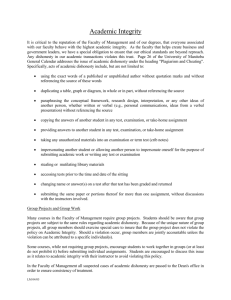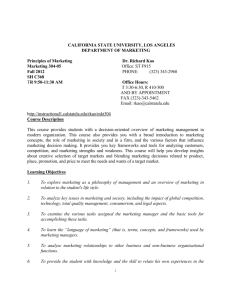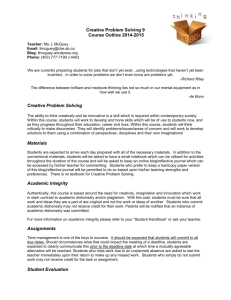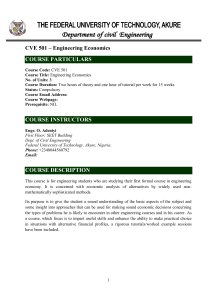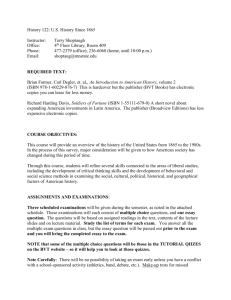Course Outline - University of Manitoba
advertisement
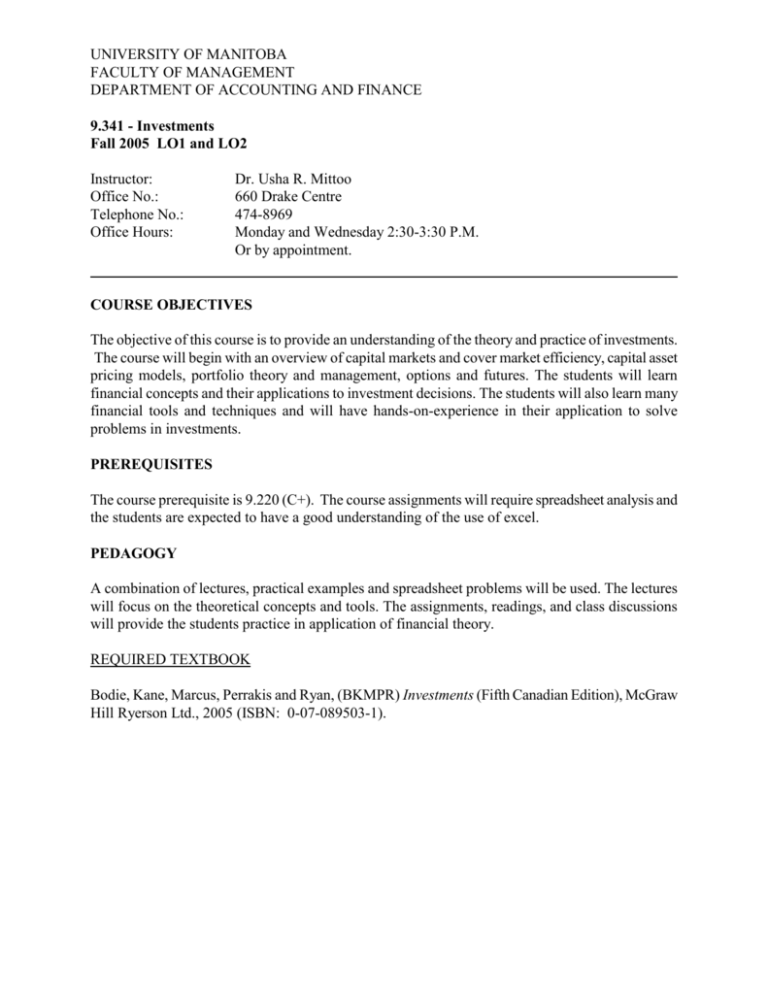
UNIVERSITY OF MANITOBA FACULTY OF MANAGEMENT DEPARTMENT OF ACCOUNTING AND FINANCE 9.341 - Investments Fall 2005 LO1 and LO2 Instructor: Office No.: Telephone No.: Office Hours: Dr. Usha R. Mittoo 660 Drake Centre 474-8969 Monday and Wednesday 2:30-3:30 P.M. Or by appointment. COURSE OBJECTIVES The objective of this course is to provide an understanding of the theory and practice of investments. The course will begin with an overview of capital markets and cover market efficiency, capital asset pricing models, portfolio theory and management, options and futures. The students will learn financial concepts and their applications to investment decisions. The students will also learn many financial tools and techniques and will have hands-on-experience in their application to solve problems in investments. PREREQUISITES The course prerequisite is 9.220 (C+). The course assignments will require spreadsheet analysis and the students are expected to have a good understanding of the use of excel. PEDAGOGY A combination of lectures, practical examples and spreadsheet problems will be used. The lectures will focus on the theoretical concepts and tools. The assignments, readings, and class discussions will provide the students practice in application of financial theory. REQUIRED TEXTBOOK Bodie, Kane, Marcus, Perrakis and Ryan, (BKMPR) Investments (Fifth Canadian Edition), McGraw Hill Ryerson Ltd., 2005 (ISBN: 0-07-089503-1). Additional Readings Selected additional readings will be placed on the reserve in the Albert D. Cohen Management Library. The students should read the assigned material prior to its coverage in class. In addition, internet will also be used for some resource material and data collection. The end-of-chapter questions and problems from the textbook and other reading materials will be assigned weekly. Students are strongly advised to work on these assignments independently and to correct their own solutions with the master copy in the Albert D. Cohen Management Library. EVALUATION In class Quizzes Assignments Final Examination 30% 20% 50% Assignments may be done in groups of two or three. Only one assignment per group should be submitted. Page 2 of 4 READING LIST ESTIMATED TIME PERIOD September 8 – 21 Computer lab: (Instructor: Zhou Zhang) September 14, 2005, Wednesday “Financial Modelling with excel” September 26 – October 19 Assignment 1 Due date September 28, 2005 In class Quiz 1, October 3, 2005 (10 marks) TOPIC Basic Principles and Concepts - Overview Basic Principles and Concepts - Overview BKMPR Chapters 1- 3 How Securities are Traded? Mutual Funds and Institutional Environment, Risk and Return BKMPR Chapters 3-5 Portfolio Selection BKMPR Chapter 6 The Equilibrium in Capital Markets The Capital Asset Pricing Model, Index Models Empirical Evidence on Stock Returns BKMPR Chapters 7-8 October 24 – 31 Market Efficiency BKMPR Chapter 9 International Investing BKMPR Chapter 22 October 31- November 9 Futures and Forward Markets BKMPR Chapter 19 In class Quiz 2, November 2, 2005 (10 marks) Assignment 2 Due date November 7, 2005 November 9 – 28 The Options and other Derivatives BKMPR Chapters 17-18 In class Quiz 3, November 21, 2005 (10 marks) November 28 - December 7 Portfolio Performance Evaluation BKMPR Chapters 20 and 21 Page 3 of 4 Academic Integrity It is critical to the reputation of the Asper School of Business and of our degrees, that everyone associated with our faculty behave with the highest academic integrity. As the faculty that helps create business and government leaders, we have a special obligation to ensure that our ethical standards are beyond reproach. Any dishonesty in our academic transactions violates this trust. Page 29 of the University of Manitoba General Calendar addresses the issue of academic dishonesty under the heading "Plagiarism and Cheating". Specifically, acts of academic dishonesty include, but are not limited to: - using the exact words of a published or unpublished author without quotation marks and without referencing the source of these words - duplicating a table, graph or diagram, in whole or in part, without referencing the source - paraphrasing the conceptual framework, research design, interpretation, or any other ideas of another person, whether written or verbal (e.g., personal communications, ideas from a verbal presentation) without referencing the source - copying the answers of another student in any test, examination, or take-home assignment - providing answers to another student in any test, examination, or take-home assignment - taking any unauthorized materials into an examination or term test (crib notes) - impersonating another student or allowing another person to impersonate oneself for the purpose of submitting academic work or writing any test or examination - stealing or mutilating library materials - accessing tests prior to the time and date of the sitting - changing name or answer(s) on a test after that test has been graded and returned - submitting the same paper or portions thereof for more than one assignment, without discussions with the instructors involved. Group Projects and Group Work Many courses in the Asper School of Business require group projects. Students should be aware that group projects are subject to the same rules regarding academic dishonesty. Because of the unique nature of group projects, all group members should exercise special care to insure that the group project does not violate the policy on Academic Integrity. Should a violation occur, group members are jointly accountable unless the violation can be attributed to a specific individual(s). Some courses, while not requiring group projects, encourage students to work together in groups (or at least do not prohibit it) before submitting individual assignments. Students are encouraged to discuss this issue as it relates to academic integrity with their instructor to avoid violating this policy. In the Asper School of Business all suspected cases of academic dishonesty are passed to the Dean's office in order to ensure consistency of treatment. Page 4 of 4
